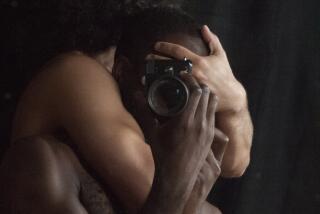In Her Image
- Share via
It was an exercise in humor watching one of the world’s most celebrated photographers posing for a photographer herself.
Annie Leibovitz, 50, in town recently to promote her new book, “Women” (Random House), couldn’t decide whether her trademark round glasses should be on, off or thrown on the big white bed behind her.
Clearly, she was uncomfortable. “And I’m sorry,” she told the photographer, with whom she was steadfastly trying not to collaborate (although a few Leibovitz suggestions about window lights and props escaped her lips). “I wish I could project like others do. I might look OK, but I’m crying inside, really.”
The reporter tried to help her relax: “Remember school photos, Annie?” “Yes,” came the quick, giggled reply. “I remember they were over fast.”
As she settled her 6-foot frame into a large sofa, Leibovitz said she produced the book because “women have a tremendous power in image in this society, and I think I wanted to hold up a mirror for women to see themselves without an agenda attached to it. . . .
“When Susan [Sontag, a longtime friend] suggested the concept, I decided to run with it. And it wasn’t until about halfway through that I felt I had even come close to nailing it.”
*
The book is filled with an astounding range of female faces, body types, professions, relationships and moods, and includes an essay by Sontag, who writes, “It is worth recalling that there are parts of the world where being photographed is something off-limits to women.”
The 100-plus portraits in the book--some taken from Leibovitz’s Vanity Fair and Vogue work, some originals shot for the project--also celebrate the diversity of feminine beauty.
There are athletes such as Martina Navratilova and Serena and Venus Williams; power brokers such as Madeleine Albright and Hillary Rodham Clinton; maids and washerwomen; scientists and astronauts; a performance artist roped to a crucifix; judges; strippers and showgirls; survivors of domestic abuse; film stars; even Norma McCorvey, the Jane Roe of Roe vs. Wade, clutching a gold crucifix, eyes closed in evangelical fervor. It is also a book of great heart, one that opens with a photograph of Leibovitz’s own mother, Marilyn. “It was suggested to me that since my mom was the first woman I knew, she’d be a great opening subject,” said Leibovitz, who added that her mother was not happy with the result, feeling that her face looked too stern.
*
That photo session, apparently, was emotional for mother and daughter (“Photographing people you know very well is always difficult,” Leibovitz said). It wasn’t until the promoters for a recent gallery show in Washington, D.C., used her mother’s photo next to Hillary Clinton’s that her mom “decided she loved the photo,” said Leibovitz, laughing.
“She got all kinds of great attention from her friends,” Leibovitz said, even compliments from the president and first lady, who threw a book bash for “Women” at the White House.
“I hope women see these images and understand that any way you look is a good thing, and not to worry so much about being judged ‘attractive’ or not,” Leibovitz said. “That’s a message that’s bombarded us all.”
She mentioned a series of photos of Las Vegas showgirls at the end of the book, women who were photographed twice, once in full stage regalia and then starkly bare-faced. “I don’t find either image more or less attractive, really,” said Leibovitz, “because each of the women is exactly who she is in each photo. I think that’s what makes the difference.”
More to Read
Sign up for our Book Club newsletter
Get the latest news, events and more from the Los Angeles Times Book Club, and help us get L.A. reading and talking.
You may occasionally receive promotional content from the Los Angeles Times.










